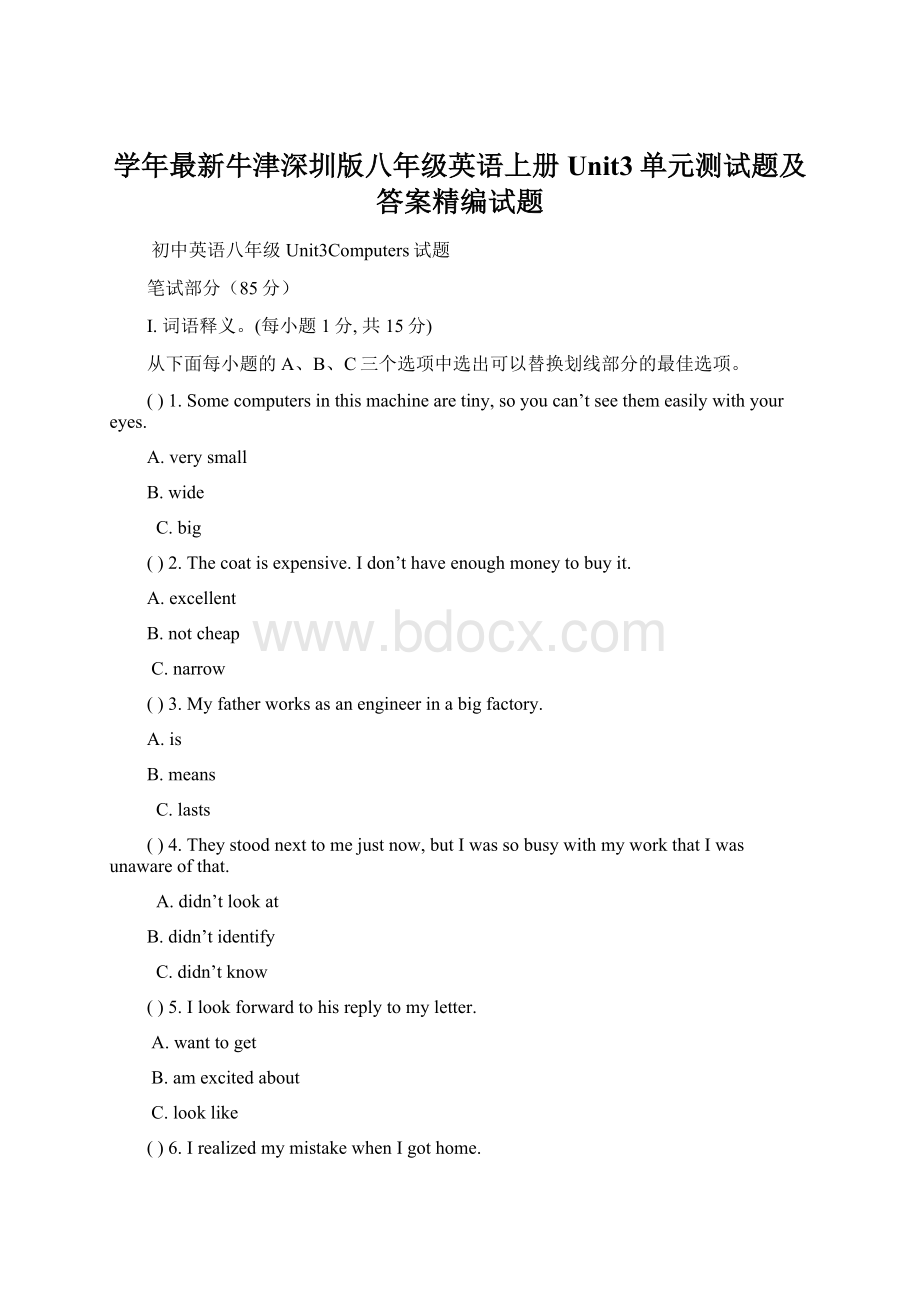学年最新牛津深圳版八年级英语上册Unit3单元测试题及答案精编试题.docx
《学年最新牛津深圳版八年级英语上册Unit3单元测试题及答案精编试题.docx》由会员分享,可在线阅读,更多相关《学年最新牛津深圳版八年级英语上册Unit3单元测试题及答案精编试题.docx(10页珍藏版)》请在冰豆网上搜索。

学年最新牛津深圳版八年级英语上册Unit3单元测试题及答案精编试题
初中英语八年级Unit3Computers试题
笔试部分(85分)
I.词语释义。
(每小题1分,共15分)
从下面每小题的A、B、C三个选项中选出可以替换划线部分的最佳选项。
()1.Somecomputersinthismachinearetiny,soyoucan’tseethemeasilywithyoureyes.
A.verysmall
B.wide
C.big
()2.Thecoatisexpensive.Idon’thaveenoughmoneytobuyit.
A.excellent
B.notcheap
C.narrow
()3.Myfatherworksasanengineerinabigfactory.
A.is
B.means
C.lasts
()4.Theystoodnexttomejustnow,butIwassobusywithmyworkthatIwasunawareofthat.
A.didn’tlookat
B.didn’tidentify
C.didn’tknow
()5.Ilookforwardtohisreplytomyletter.
A.wanttoget
B.amexcitedabout
C.looklike
()6.IrealizedmymistakewhenIgothome.
A.knew
B.made
C.had
()7.Don’tbother(打扰)theman.Heistyping.
A.writingonthepaper
B.writingwithapen
C.writingwithacomputer
()8.TheweatherhereisbecomingcolderandcolderandIdon’twanttogooutsidetoplay.
A.seeming
B.getting
C.making
()9.It’sveryconvenienttousethecomputerstocalculate.
A.guesstheanswer
B.workouttheanswer
C.lookforinformation
()10.Davidispopularamongstudentsinourschool.
A.isbeautifulamong
B.iskindto
C.islikedby
()11.Idon’tknowhowtooperatethismachine.
A.fix
B.workwith
C.buy
()12.Weareabletocompletethework.
A.havetheabilityto
B.tryto
C.wantto
()13.Whathappenedtohim?
Helooksverysad.
A.isgoodfor
B.canhelp
C.iswrongwith
()14.JimisgoodatsolvingMathsproblems.
A.isinterestedin
B.doeswellin
C.enjoys
()15.Humanbeing’sbrainscanproducenewideaswhilecomputerscannot.
A.create
B.protect
C.catch
II.语法填空。
(每小题1分,共10分)
阅读下面短文,按照句子结构的语法性和上下文连贯的要求,在空格处填入一个适当的词或使用括号中词语的正确形式填空。
Hello,I’mBruce.Ihavethreegood(16)______(friend).Wearedifferent(17)______eachother.Jackisthirteenyearsold.Heisoneyear(18)_______(old)thanme.Andheismuchtallerthananyoneofus.Heistalentedforsports.Andfootballishisfavoritesport.Tomisastallasme.Heisvery(19)______(fun)andoutgoing.Heoften(20)______(make)uslaugh.Webothlike(21)______(read).Henryisoneyearyoungerthanme.Andheisshorterthananyofus.(22)______heisasheavyasme.Heisgoodat(23)______(draw).Helikesdrawingpicturesalot.
I’m(24)_____(quiet)thanthem.Butweareallfriendlytoeachother(25)______canshareeverything.
III.完形填空。
(每小题1.5分,共15分)
阅读下面短文。
从短文后所给的A、B、C三个选项中选出最佳选项。
ThecomputerandtheInternethavemadeahugechangeinpeople'slives.Peoplecan't__26__theirliveswithoutthem.Nowsittinginfrontofthetableandclickinga__27__,peoplecaneasilygetontheInternet.Over80percentofpeopleintheworld__28__theInterneteveryday.BecauseoftheInternet,peoplecan__29__shareknowledge.LivesbeforeandaftertheinventionofthecomputerandtheInternetaretotally__30__,andthebiggestchangesareaboutcommunicationandinformation.First,peopleall__31__tohavetheeasiestwaytocommunicate(沟通)withothers.Withthe__32__oftheInternet,peoplecaneasilytalkwithothers.Besides,peoplecaneasilyreceive(收到)informationthroughtheInternet.UsingtheInternet,peoplecan__33__allkindsofinformationtheyneed.Peoplecanknowmanythingsandgetalotofinformationintheworld__34__theystayathome.Inthepast,itwasnot__35__tofindinformationinstantlyathome.
()26.A.formB.know
C.imagine
()27.A.monitorB.mouse
C.speaker
()28.A.useB.look
C.get
()29.A.actuallyB.quickly
C.slowly
()30.A.differentB.same
C.difficult
()31.A.agreeB.remain
C.want
()32.A.feelingB.advice
C.help
()33.A.lookB.find
C.identify
()34.A.soB.because
C.when
()35.A.possibleB.interesting
C.cheerful
IV.阅读理解。
(每小题1.5分,共30分)
阅读下列短文,从下面每小题的A、B、C、D四个选项中选出最佳选项。
A
WhenIwasinelementaryschool,Igotintoamajorargument(争论)withaboyinmyclass.IhaveneverforgottenthelessonIlearntthatday.
Theteacherbroughtusuptothefrontoftheclassroomandplacedhimononesideofherdeskandmeontheother.Inthemiddleofherdeskwasalargeandroundobject.Icouldclearlyseethatitwasblack.Sheaskedtheboywhatcolourtheobjectwas."White,"heanswered.
Icouldn'tbelieve(相信)hesaidtheobjectwaswhite,whenitwasobviously(明显地)black!
Theargumentaboutthecolouroftheobjectstartedbetweenmyclassmateandme.
TheteachertoldmetogoandstandwheretheboyhadbeenandtoldhimtocomeandstandwhereIhadbeen.Wechangedplaces,andthensheaskedmewhatthecolouroftheobjectwas.I
hadtoanswer,"White."
Itwasanobjectwithtwodifferentlycolouredsides,andfromhisviewpointitwaswhite.Only
frommysidewasitblack.
Sometimesweneedtolookattheproblemfromtheotherpersonsviewinordertotrulyknowhis/heridea.
()36.Wheredidtheargumenthappen?
A.Intheclassroom.
B.Outsidetheclassroom.
C.Inthelibrary.
D.Ontheplayground.
()37.Whatcolourwastheobjectfromtheboy'sside?
A.Whiteandblack.
B.Black.
C.White.
D.Wedon'tknow.
()38.Whatmadetheargumentend?
A.Theteachertoldthemthetruth.
B.Theteacherchangedtheplacestheystood.
C.Theirclassmatestoldthemthetruth.
D.Theyfeltboredwiththeargument.
()39.Whatkindofobjectwasit?
A.Onesmallandroundobject.
B.Twosideswiththesamecolour.
C.Twosideswithdifferentcolours.
D.Onelargeandsquare(正方形的)object.
()40.Whichofthefollowingcanbethebesttitleforthepassage?
A.Anargumentwithmyclassmate.
B.AgoodteacherIoncemet.
C.AlessonIlearnt.
D.Don'targuewithothers.
B
Tokyoisoneofthemostconfusingcitiesintheworld.Over20millionpeopleliveandworkintheTokyoarea,andmanyworld-famouscompanieshavetheirofficesthere.Butmoststreetsdon'thavenames.SohowcanyoufindyourwayinTokyo?
MostpeopleinTokyoareverygoodatgivingdirections.Theycanusuallyexplain(说明)howtogettotheirhomeortheirofficefromthenearesttrainstation.PeopleinTokyooftenusemapswhentheygivedirections.
Advertisementsinnewspapersormagazines,forexample,usuallyhaveasmallmaptohelpyoufindthecompany.Ifyouaregoingtovisitsomeone'shouse,it'sagoodideatoaskthepersontodrawamapofthelocalarea.Ifyougetlost,thebestideaistogotoapolicestation.InJapan,
eachneighborhoodhasasmallpolicestation,andthepoliceofficerstherehaveamapofallthebuildingsinthearea.Givingdirectionsisanimportantpartoftheirjob.
()41.WhyisTokyooneofthemostconfusingcitiesintheworld?
A.Becauseithasaverylargepopulation.
B.Becausemoststreetsdon'thavenames.
C.BecausepeopleinTokyoarebadatgivingdirections.
D.Becausetoomanyfamouscompanieshavetheirofficesthere.
()42.WhichofthefollowingmustyouhavewhenyougotoTokyo?
A.Apen.
B.Amagazine.
C.Amap.
D.Anewspaper.
()43.What'sthebestchoiceforyouifyougetlostinTokyo?
A.Askthepoliceforhelp.
B.Findamapofthelocalarea.
C.Askthepasser-byforhelp.
D.Findthenearesttrainstation.
()44.WhichofthefollowingisTRUEaboutTokyo?
A.Tokyohas20millionpeople.
B.It'snoteasyformostpeopletofindthenearestwaytotheirhouses.
C.Advertisementsinnewspapersseldomhaveasmallmap.
D.Thepoliceofficersaregoodatgivingdirections.
()45.Whatisthepassageabout?
A.HowtofindawayinTokyo.
B.HowtogettotheofficeinTokyo.
C.WhentogotoTokyo.
D.Whentovisitsomeone'shouse.
C
Tohaveahealthyvision,it'sagoodideatosetrulesforyourchildrenwhenitcomestotheamountoftimetheyspendinfrontofthecomputer.
1.Haveyourchild'svisionchecked.Beforestartingschool,everychildshouldhaveaneyeexam,includingnear-point(computerandreading)anddistancetesting.
2.Controltheamountoftime.Yourchildmayspendallhisorhersparetimeonthecomputerwithoutabreak.Encouragekidstotake20-secondbreaksfromthecomputerevery20minutestoreduce(减少)thedevelopmentofeyefocusingproblems.(Someeyedoctorscallthisthe"20-20rule".)
3.Checktheworkstation.Foryoungandsmallchildren,makesurethecomputerworkstationisadjusted(调整)totheirbodysize.Therightdistancebetweenthemonitorandtheeyeforchildrenis18to28inches.Viewingthecomputerscreencloserthan18inchescanmaketheeyes
nervous.
4.Checkthelighting.Toreduceglare(刺眼的光),windowsandotherlightsourcesshouldnotbedirectlyvisiblewhensittinginfrontofthemonitor.Reducetheamountoflightingintheroomtomatchthecomputerscreen.
()46.Whatdoestheunderlinedword"vision"mean?
A.Theabilitytothink.
B.Theabilitytosee.
C.Theabilitytodream.
D.Theabilitytohear.
()47.Whatisthe20-20rule?
A.Take20-secondbreaksevery20seconds.
B.Take20-secondbreaksevery2minutes.
C.Take20-minutebreaksevery20minutes.
D.Take20-secondbreaksevery20minutes.
()48.WhichofthefollowingisNOTrightaboutthedistancebetweentheeyeandthemonitor?
A.17inches.
B.27inches.
C.19inches.
D.21inches.
()49.Whatistheadvicebeforestartingschool?
A.Checkingthelighting.
B.Checkingtheworkstation.
C.Checkingthechild'svision.
D.Controllingtheamountoftime.
()50.Whomightthepassagebewrittenfor?
A.Teachers.
B.Parents.
C.Children.
D.Doctors.
D
MostparentslovetheInternetandwanttheirkidsto